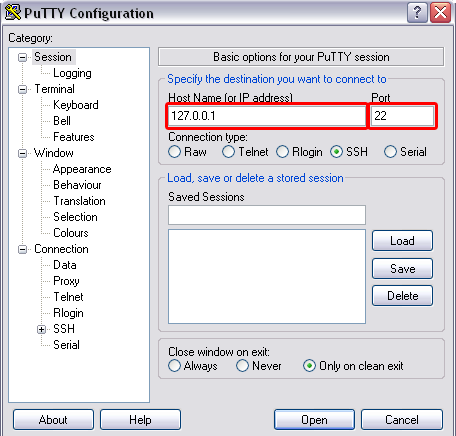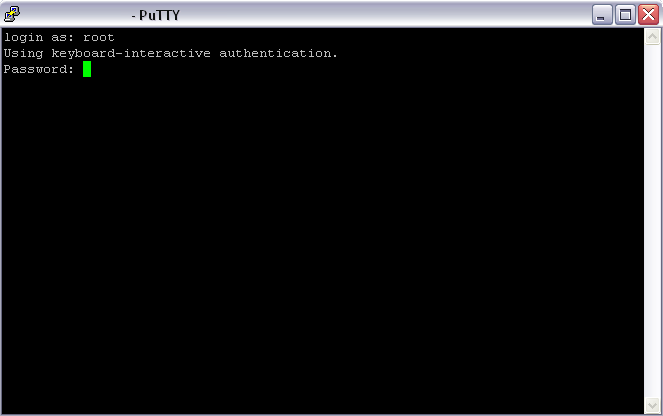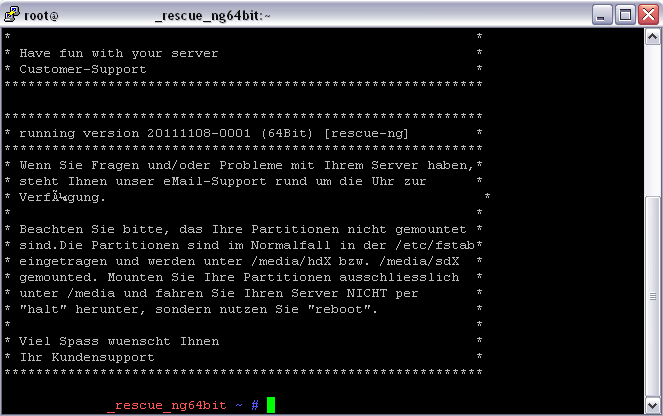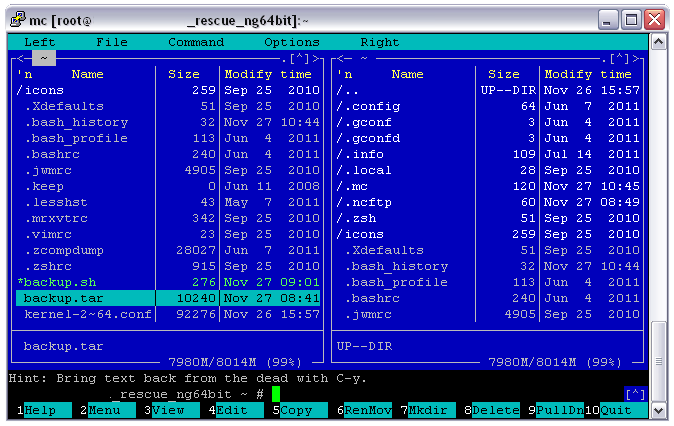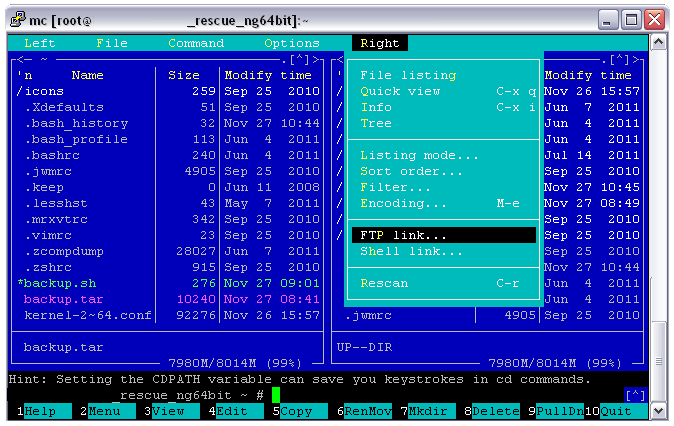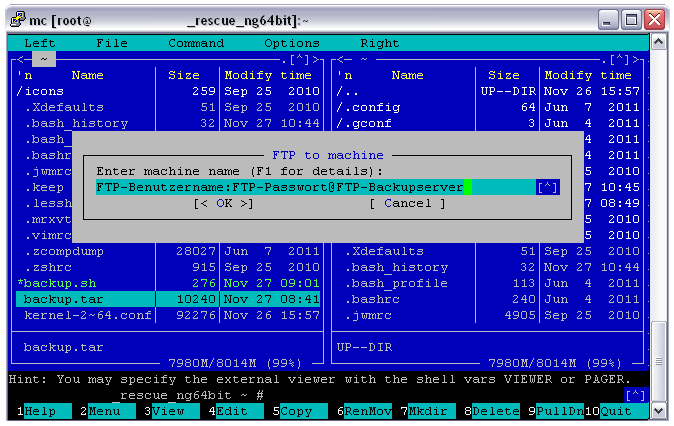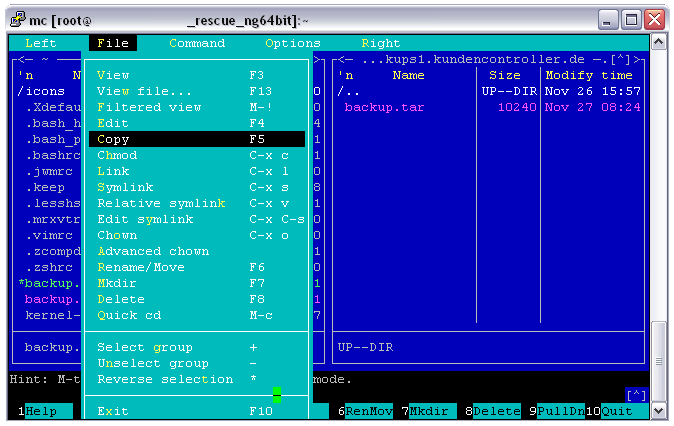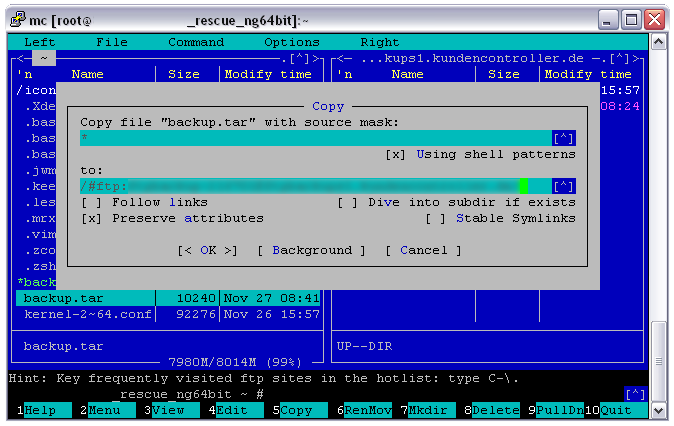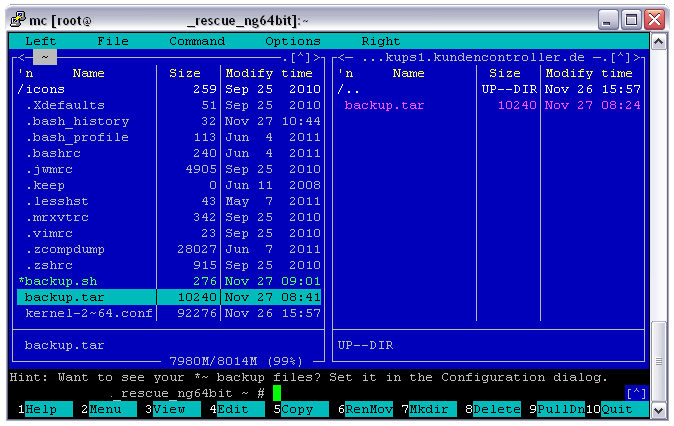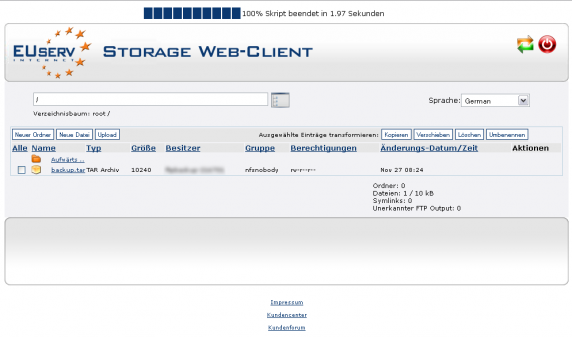Manual Backup Linux Rescue System/en
Aus EUserv Wiki
Root (Diskussion | Beiträge) |
Root (Diskussion | Beiträge) |
||
| Zeile 10: | Zeile 10: | ||
== General== | == General== | ||
| - | If you have an EUserv server or virtual server plan, you have the | + | If you have an EUserv server or virtual server plan, you have the opportunities to start this on the EUserv customer service center in the rescue mode. |
| + | |||
| + | With the function '''Rescue System''' you can connect to your server, for example if an operating system installation is not successful or if the server is not accessible from the usual way. After it is started in the rescue mode, you can perform a backup of your user and configuration settings. This is a great necessity if your hard drive is malfunction, the system and the software are no longer works and critical data must be protected. | ||
| - | |||
== Preparing and activating the rescue system == | == Preparing and activating the rescue system == | ||
| - | First, | + | First, your server or virtual server must boot up in the rescue system. How to do this, you'll find [[Kundencenter_Server_Rescue_System|here]]. |
| - | |||
| - | After your server or virtual server is booted in the rescue system, you can connect | + | == Connect with the rescue system == |
| + | |||
| + | After your server or virtual server is booted in the rescue system, you can connect using SSH program (for example, '''Putty'''). Simply start '''Putty''' and enter the IP address of your server. | ||
<br> | <br> | ||
<br> | <br> | ||
<center> | <center> | ||
| - | [[Datei:putty_1_neu.png | + | [[Datei:putty_1_neu.png]] |
</center> | </center> | ||
<br> | <br> | ||
<br> | <br> | ||
| - | It is important that '''Port''' is set at '''22''' and '''Connection type: SSH''' is selected.<br> | + | It is important that a '''Port''' is set at '''22''' and '''Connection type: SSH''' is selected.<br> |
| - | Now click on the button '''Open''' and the SSH connection to your server | + | Now click on the button '''Open''' and the SSH connection to your server is set up. <br> |
| - | It appears a console window in which you are asked to enter your | + | It appears in a console window in which you are asked to enter your user name and password. Here you enter your '''root''' and the '''default password''' of your server. To find this information, you'll see [[Kundencenter_Server_Serverdaten#Konfigurations-Daten_des_Servers|here]]. |
<br> | <br> | ||
<br> | <br> | ||
<center> | <center> | ||
| - | [[Datei:putty_2.png | + | [[Datei:putty_2.png]] |
</center> | </center> | ||
<br> | <br> | ||
| Zeile 43: | Zeile 45: | ||
<br> | <br> | ||
<center> | <center> | ||
| - | [[Datei:putty_3.png | + | [[Datei:putty_3.png]] |
</center> | </center> | ||
<br> | <br> | ||
<br> | <br> | ||
| - | == Create backup and backup the | + | == Creating and storing a backup on a FTP server == |
| + | |||
| + | === Mounting the partition === | ||
| + | |||
| + | First create a directory under /media in which you can mount the respective hdd partition: | ||
| + | |||
| + | mkdir /media/backup | ||
| + | |||
| + | First you have to mount the hard disk drive partitions of your installed system in the directory tree, because you are in the rescue system. In the following you can find a overview of the partition schemes of our standard installations: | ||
| + | |||
| + | |||
| + | ==== Partitioning scheme 1 ==== | ||
| + | |||
| + | Standard partitioning for GRUB Legacy systems (CentOS, Gentoo, OwnCloud): | ||
| + | |||
| + | <pre> | ||
| + | /dev/sda1 --> /boot (GRUB files, kernel und initrd) | ||
| + | /dev/sda2 --> swap | ||
| + | /dev/sda3 --> / (data partition, contains e.g. etc, var, home) | ||
| + | </pre> | ||
| + | |||
| + | Mount the data partition according to the used scheme: | ||
| + | |||
| + | mount /dev/sda3 /media/backup | ||
| + | |||
| + | |||
| + | ==== Partitioning scheme 2 ==== | ||
| + | |||
| + | Standard partitioning for GRUB2 systems (Debian, Ubuntu, OpenSuse, Fedora, Proxmox): | ||
| + | |||
| + | <pre> | ||
| + | /dev/sda1 --> BIOS-GRUB-Partition | ||
| + | /dev/sda2 --> /boot (GRUB files, kernel und initrd) | ||
| + | /dev/sda3 --> swap | ||
| + | /dev/sda4 --> / (data partition, contains e.g. etc, var, home) | ||
| + | </pre> | ||
| + | |||
| + | Mount the data partition according to the used scheme: | ||
| + | |||
| + | mount /dev/sda4 /media/backup | ||
| + | |||
| + | ==== Partitioning scheme 3 ==== | ||
| + | |||
| + | Standard partitioning for GRUB2 systems (see above) with RAID1: | ||
| + | |||
| + | <pre> | ||
| + | /dev/md0 --> BIOS-GRUB-Partition | ||
| + | /dev/md1 --> /boot (GRUB files, kernel and initrd) | ||
| + | /dev/md2 --> swap | ||
| + | /dev/md3 --> / (data partition, contains e.g. etc, var, home) | ||
| + | </pre> | ||
| + | |||
| + | Mount the data partition according to the used scheme: | ||
| + | |||
| + | mount /dev/md3 /media/backup | ||
| + | |||
| + | |||
| + | === Creating a backup of critical data === | ||
| + | |||
| + | To perform a backup of your user and config data, please go as follows: | ||
| + | |||
| + | * Create a backup under the previously created directory /media/backup of your user and config files. Enter the following command in the console window of Putty: | ||
| + | |||
| + | cd /media/backup | ||
| + | tar cvf backup.tar /media/backup/etc /media/backup/home /media/backup/var | ||
| + | |||
| + | |||
| + | === Creating a backup of physical hard disk drive (hard disk drive image)=== | ||
| + | |||
| + | You have to enter the following command in the console window of Putty to create a 1:1 backup of your physical hard disk drive (replace X with the | ||
| + | corresponding partition you want to create a backup): | ||
| + | |||
| + | dd if=/dev/sdX conv=noerror,sync | gzip > /path/to/backup.gz | ||
| + | |||
| + | You can restore the partition with the following command: | ||
| - | + | gzip -dc /path/to/image.gz | dd of=/dev/sdX | |
| - | + | ||
| + | === Storing a backup on a FTP server === | ||
| - | Now you can transfer this backup e.g., on a FTP server (we recommend our BackupHD/online hard drive [[BackupHD/Onlinefestplatte | + | Now you can transfer this backup e.g., on a FTP server (we recommend our BackupHD/online hard drive [[BackupHD/Onlinefestplatte]]). To do this, by using the MidnightCommander (MC) with the following command: |
mc | mc | ||
| - | Now change to the directory where you saved the backup file ( | + | Now change to the directory where you saved the backup file (the default is the root directory), and select the backup file (backup.tar) from using the arrow keys: |
<br> | <br> | ||
<br> | <br> | ||
<center> | <center> | ||
| - | [[Datei:mc-oeffnen_neu.png | + | [[Datei:mc-oeffnen_neu.png]] |
</center> | </center> | ||
<br> | <br> | ||
<br> | <br> | ||
| - | In order now to connect with the FTP server, click on '''right''' and select '''FTP link ...''' | + | In order now to connect with the FTP server, click on the upper '''right''' and select the arrow keys '''FTP link ...''' from: |
<br> | <br> | ||
<br> | <br> | ||
<center> | <center> | ||
| - | [[Datei:mc-ftp_neu.png | + | [[Datei:mc-ftp_neu.png]] |
</center> | </center> | ||
<br> | <br> | ||
<br> | <br> | ||
| - | Now you are asked to enter your FTP server name and the user data. | + | Now you are asked to enter your FTP server name and the user data. Give this as follows: |
<br> | <br> | ||
<br> | <br> | ||
<center> | <center> | ||
| - | [[Datei:mc-ftp-machine_neu.png | + | [[Datei:mc-ftp-machine_neu.png]] |
</center> | </center> | ||
<br> | <br> | ||
<br> | <br> | ||
| - | The required data can be found in the customer service center: [[BackupHD/Onlinefestplatte | + | The required data can be found in the customer service center: [[BackupHD/Onlinefestplatte]] |
| - | Now you can copy the backup file from your server to the FTP server. Choose '''File''' --> '''Copy''': | + | Now you can copy the backup file from your server to the FTP server. Choose the above '''File''' --> '''Copy''' from: |
<br> | <br> | ||
<br> | <br> | ||
<center> | <center> | ||
| - | [[Datei:mc-ftp-copy_neu.png | + | [[Datei:mc-ftp-copy_neu.png]] |
</center> | </center> | ||
<br> | <br> | ||
<br> | <br> | ||
| - | Now the directory structure of the FTP spaces | + | Now the directory structure of the FTP spaces is appeared on which the backup file should be copied. Confirm this with OK: |
<br> | <br> | ||
<br> | <br> | ||
<center> | <center> | ||
| - | [[Datei:mc-ftp-copy-server_neu.png | + | [[Datei:mc-ftp-copy-server_neu.png]] |
</center> | </center> | ||
<br> | <br> | ||
<br> | <br> | ||
| - | + | To ensure that your backup file is transferred to the FTP server. | |
<br> | <br> | ||
<br> | <br> | ||
<center> | <center> | ||
| - | [[Datei:mc-ftp-copy-server-finish_neu.png | + | [[Datei:mc-ftp-copy-server-finish_neu.png]] |
</center> | </center> | ||
<br> | <br> | ||
<br> | <br> | ||
| - | Now you can connect with the BackupHD | + | Now you can log on to our Web client to connect with the BackupHD below http://web.storage.euserv.net. After you signed in with your FTP user data, you can now see your backup file. |
<br> | <br> | ||
<br> | <br> | ||
<center> | <center> | ||
| - | [[Datei:backuphd.png|572px | + | [[Datei:backuphd.png|572px]] |
</center> | </center> | ||
<br> | <br> | ||
<br> | <br> | ||
| - | You can download this by yourself. | + | You can download this by yourself. After a re-install in your server was necessary, you can transfer the data again to your server and unzip. You have made your user and configuration files again. |
== Backup via rsync == | == Backup via rsync == | ||
| - | Another way to create a backup of your files is using '''rsync.''' Here, the backup file | + | Another way to create a backup of your files is by using '''rsync.''' Here, the backup file is transferred directly to your BackupHD/online hard drive. To do this, you can refer to the following wiki article: |
| - | <br>[[Sicherung_Dateien_auf_BackupHD_mit_Rsync | + | <br>[[Sicherung_Dateien_auf_BackupHD_mit_Rsync#Beispiele:|Sicherung_Dateien_auf_BackupHD_mit_Rsync]] |
Version vom 16:43, 3. Nov. 2014
| | Languages: |
Deutsch |
Creating a backup with the Linux rescue system
Inhaltsverzeichnis |
Creating a backup with the Linux rescue system
General
If you have an EUserv server or virtual server plan, you have the opportunities to start this on the EUserv customer service center in the rescue mode.
With the function Rescue System you can connect to your server, for example if an operating system installation is not successful or if the server is not accessible from the usual way. After it is started in the rescue mode, you can perform a backup of your user and configuration settings. This is a great necessity if your hard drive is malfunction, the system and the software are no longer works and critical data must be protected.
Preparing and activating the rescue system
First, your server or virtual server must boot up in the rescue system. How to do this, you'll find here.
Connect with the rescue system
After your server or virtual server is booted in the rescue system, you can connect using SSH program (for example, Putty). Simply start Putty and enter the IP address of your server.
It is important that a Port is set at 22 and Connection type: SSH is selected.
Now click on the button Open and the SSH connection to your server is set up.
It appears in a console window in which you are asked to enter your user name and password. Here you enter your root and the default password of your server. To find this information, you'll see here.
If you have successfully connected with your server in the rescue mode, the following window appears:
Creating and storing a backup on a FTP server
Mounting the partition
First create a directory under /media in which you can mount the respective hdd partition:
mkdir /media/backup
First you have to mount the hard disk drive partitions of your installed system in the directory tree, because you are in the rescue system. In the following you can find a overview of the partition schemes of our standard installations:
Partitioning scheme 1
Standard partitioning for GRUB Legacy systems (CentOS, Gentoo, OwnCloud):
/dev/sda1 --> /boot (GRUB files, kernel und initrd) /dev/sda2 --> swap /dev/sda3 --> / (data partition, contains e.g. etc, var, home)
Mount the data partition according to the used scheme:
mount /dev/sda3 /media/backup
Partitioning scheme 2
Standard partitioning for GRUB2 systems (Debian, Ubuntu, OpenSuse, Fedora, Proxmox):
/dev/sda1 --> BIOS-GRUB-Partition /dev/sda2 --> /boot (GRUB files, kernel und initrd) /dev/sda3 --> swap /dev/sda4 --> / (data partition, contains e.g. etc, var, home)
Mount the data partition according to the used scheme:
mount /dev/sda4 /media/backup
Partitioning scheme 3
Standard partitioning for GRUB2 systems (see above) with RAID1:
/dev/md0 --> BIOS-GRUB-Partition /dev/md1 --> /boot (GRUB files, kernel and initrd) /dev/md2 --> swap /dev/md3 --> / (data partition, contains e.g. etc, var, home)
Mount the data partition according to the used scheme:
mount /dev/md3 /media/backup
Creating a backup of critical data
To perform a backup of your user and config data, please go as follows:
- Create a backup under the previously created directory /media/backup of your user and config files. Enter the following command in the console window of Putty:
cd /media/backup tar cvf backup.tar /media/backup/etc /media/backup/home /media/backup/var
Creating a backup of physical hard disk drive (hard disk drive image)
You have to enter the following command in the console window of Putty to create a 1:1 backup of your physical hard disk drive (replace X with the corresponding partition you want to create a backup):
dd if=/dev/sdX conv=noerror,sync | gzip > /path/to/backup.gz
You can restore the partition with the following command:
gzip -dc /path/to/image.gz | dd of=/dev/sdX
Storing a backup on a FTP server
Now you can transfer this backup e.g., on a FTP server (we recommend our BackupHD/online hard drive BackupHD/Onlinefestplatte). To do this, by using the MidnightCommander (MC) with the following command:
mc
Now change to the directory where you saved the backup file (the default is the root directory), and select the backup file (backup.tar) from using the arrow keys:
In order now to connect with the FTP server, click on the upper right and select the arrow keys FTP link ... from:
Now you are asked to enter your FTP server name and the user data. Give this as follows:
The required data can be found in the customer service center: BackupHD/Onlinefestplatte
Now you can copy the backup file from your server to the FTP server. Choose the above File --> Copy from:
Now the directory structure of the FTP spaces is appeared on which the backup file should be copied. Confirm this with OK:
To ensure that your backup file is transferred to the FTP server.
Now you can log on to our Web client to connect with the BackupHD below http://web.storage.euserv.net. After you signed in with your FTP user data, you can now see your backup file.
You can download this by yourself. After a re-install in your server was necessary, you can transfer the data again to your server and unzip. You have made your user and configuration files again.
Backup via rsync
Another way to create a backup of your files is by using rsync. Here, the backup file is transferred directly to your BackupHD/online hard drive. To do this, you can refer to the following wiki article:
Sicherung_Dateien_auf_BackupHD_mit_Rsync

